|
WINTER DRIVING TIPS
|
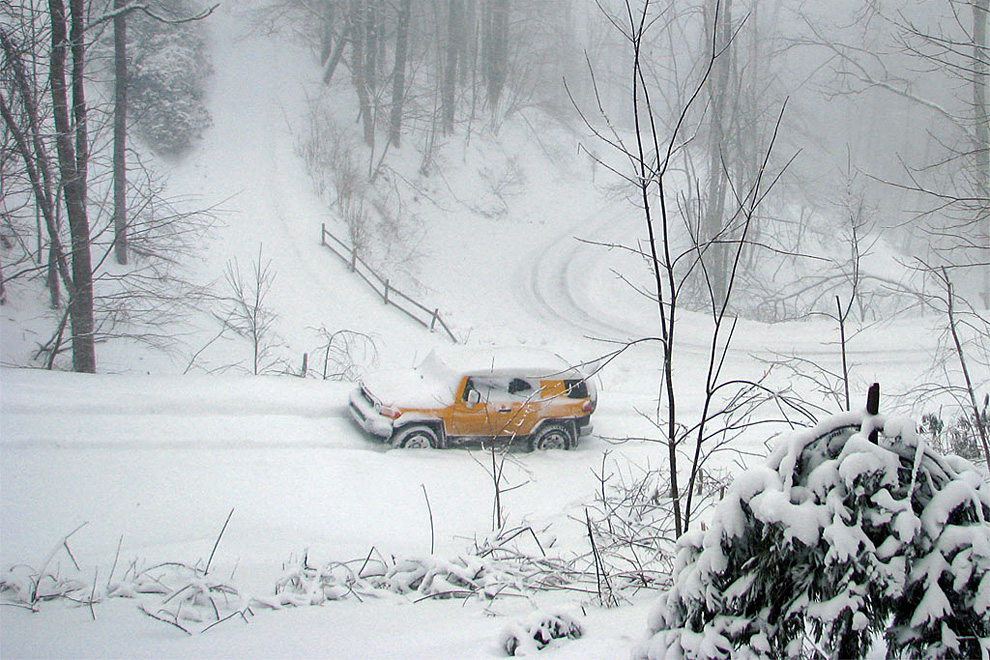 |
Blue Ridge Vacations – Western North Carolina Winter Driving Tips |
Follow Us and Subscribe:         |
Western North Carolina Winter Driving Tips |
#Ad • Find The Best Western North Carolina Vacation Guides |
Winter Driving Tips For The Western North Carolina Mountains
The Western North Carolina High Country is in the Southeastern United States at around 3,400’ elevation. Western North Carolina Winter temperatures can reach -25°F, even colder with the wind chills.Boone NC Snow falls average about 3 to 4 feet per year. (Photo: Top). If you’re from the South and not used to driving in deep snow and ice, in severe cold temperatures, please read on... Boone NC Weather Forecast
Follow Us On YouTube
|
Western North Carolina Winter Driving Tips |
Winter Driving in the Western North Carolina Blue Ridge Mountains
Winter Driving in the Western North Carolina Blue Ridge Mountains is a whole lot different than winter driving in the Low Country, or on straight and level, clean city streets.North Carolina Highway Conditions
1 (877) DOT-4YOU should be checked before you travel to the Western North Carolina High Country and the Blue Ridge Mountains of Western North Carolina.Dress Warmly
Winter Boots, Layered Clothing, a Hat and Gloves are the General Rule.When You See Snow and Ice – PleaseSlow Down!
The First Tip for Winter Driving in the Blue Ridge Mountains is to SLOW DOWN!Don’t Tail Gate
The Second Tip is BACK OFF and DON’T TAIL GATE! If the road is snow or ice covered, use 2nd Gear instead of Drive (D). Do not exceed 25 mph on snow and ice! Go especially slow on curves and steep hills, which are everywhere up here. Stopping distances are greatly increased when on snow and ice!Traction Control
The Third Tip is Traction Control. If your vehicle has Traction Control, Turn It Off, so both tires turn rather than the one when traction control is activated!Check the Boone NC Weather Forecast! Know Where You’re Going
Always tell someone where you are going and when you expect to arrive. We’ve seen many cars go off the road and into the ditch, especially in winter!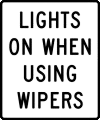 Rain, Snow and Fog
North Carolina State Law requires the use of headlights when windshield wipers are in use. Daytime Running Lights don’t qualify as headlights, so turn your headlights on. Daytime Running Lights also don’t turn on the rear tail lights, which are necessary in poor visibility, like snow, fog and rain. Clean off your headlights of salt deposits, snow and ice. This makes a huge difference in seeing and being seen. Fog is a very common occurrence in the Blue Ridge Mountains, especially along the Blue Ridge Parkway. Always turn on your headlights in fog, snow and rain. If you have, turn them on as well. It amazes me how many tourists drive on the Blue Ridge Parkway in Very Dense Fog with their headlights off!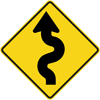 Windy Mountain Roads
These roads are constructed by cutting into the side of the mountain or may follow the edges of a river, so you will see this sign a lot. Many are very windy with many blind curves, steep hills, with deep cliffs along the outer edges. Secondary Roads (hence the name), don’t get scraped or salted until the Primary Roads are finished, which can be later morning or early afternoon. You might be cutting snow ruts early in the morning, or following in them later on. Shady areas, especially North facing slopes, are often covered in black ice, and can be extremely slippery.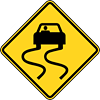 Slippery Curvy Roads
These cause a lot of Mountain Car accidents. Just look at the guard rail scrap marks for proof. Add in deer, shaded areas where nothing melts, freezing rain and black ice, and you have some very unique winter driving conditions. If you start to skid, don’t panic! Turn the steering wheel in the direction of the skid, but don’t over correct. The safe way to stop is to ‘stomp and steer.’ Never pump anti-lock brakes.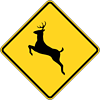 Deer Crossings
Deer are everywhere in the North Carolina Blue Ridge Mountains. Deer Accidents can total your vehicle! Deer will often venture onto road sides in search of road salt to lick in the winter months. If you spot one deer, slow down and look for the other two, as deer usually travel in small groups of 2 or 3. Deer will often venture out onto the sides of the road to eat road salt. Deer will follow fixed migration paths, or deer paths, so when you see a Deer Crossing Sign, it’s usually located to a deer trail. Always Stay Alert for Deer! We are big believers in using Deer Whistles!#Ad • Save-A-Deer Whistle 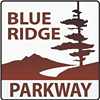 The Blue Ridge Parkway – Often Closed For The Winter Months
If you are traveling along the Blue Ridge Parkway, note the Mileposts from time to time, to keep track of exactly where you are. If you happen to slide off the Blue Ridge Parkway, you could be way down in the woods for a very long time, even days, before anyone finds you. Many sections of the Blue Ridge Parkway are closed during inclement winter weather. Check the Blue Ridge Parkway Closure Map.Older GPS Maps and Cell Phones
Older GPS devices and maps are often incorrect up here. Cell Phones often don’t work along the Blue Ridge Parkway, due to the lack of Cell Towers and any AC Power. Carry a Paper Map of the area as a backup. Be prepared to take an alternative route if ice, snow or fallen tree branches are blocking the road. The higher up you go, the colder it gets.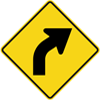 Right Curves
This isn’t NASCAR folks! Be very cautious when driving on Blind Right Curves while driving in the North Carolina Blue Ridge Mountains. One extremely dangerous bad habit among many locals up here is crossing over the double yellow lines, or “Driving Left of Center”, when driving on Blind Left Curves. Note the worn away double yellow lines on many local curves. We drive with one thumb over the horn, just in case. |
Winter Driving Preparation In October |
Severe Snow Rated Tires and a 4x4 Drive Vehicle
If you have a 4x4 SUV or AWD Vehicle – Bring It!Winter Driving Techniques can take years to master, and vary from one vehicle to another. Severe Snow Rated Tires play an important role! Having lived year-round in the Blue Ridge Mountains since 1998, our Toyota RAV4 TRD Off Road is equipped with Severe Snow Rated Falken Wildpeak At Trail Tires for extreme winter travel in the Blue Ridge Mountains of Western North Carolina – In all Four Seasons. Severe Snow Rated Snow Tires
For All Weather Driving in the Western North Carolina Blue Ridge Mountains, we use and highly recommend Severe Snow Rated Falken Wildpeak AT Trail Tires, which are perfect for our windy and snowy mountain roads. Severe Snow Rated, but can also be driven year round, highways, gravel, mud, snow and ice.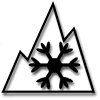 Severe Snow Rating
The Severe Snow Rating is being used by major North American Tire Manufacturers. The tires are marked on the sidewall with a snowflake-on-the-mountain symbol which identifies those tires that meet the required performance in Severe Snow Conditions. We use and recommend Severe Snow Rated snow tires for better traction on ice and snow. Use a matching set of deep tread Snow tires that meet the Severe Snow Standard. Snow tires are highly recommended for use during the snow season from October to April. Tire Chains can be used up here in deep snow, but most are limited to 30 mph, and can take a lot of time to install correctly.Check Your Tire Depth
The tread depth of your car tires should be at least 1/8” or greater. 4x4 Truck tires should have at least 1/4” tread or greater for deep snow. Make sure you have Tire Valve Caps to keep out the snow and ice.#Ad • Tire Valve Caps Use a Digital Tire Pressure Gauge
Check your tire pressure more often in the winter months. A Digital Tire Pressure Gauge is recommended because it’s more accurate. Tire pressure decreases as the temperature drops, so add a two to four pounds of extra air in the winter months.#Ad • Digital Tire Pressure Gauge Gasoline Shortages Are Common
Keep your gas tank at least half full. It is recommended that you fill up once you arrive up here. You don’t want to be stranded in the mountains without enough gasoline to get back home. There are NO GAS STATIONS on the Blue Ridge Parkway, which is often closed in the winter.See our List of North Carolina Blue Ridge Parkway Fuel Exits. Blowing Rock NC only has 2 gas stations in town, and they can easily run out of gas on busy weekends, ASU Football Games or Large Concerts, or if the fuel truck can’t make it up the mountain roads in bad winter weather. Carrying an Extra 5 Gallon Gas Can with you, can get you home safely, especially when driving on the Blue Ridge Parkway.  Attention Rear Drive Vehicles – Adding two more 50 lb. bags of coarse Tube Sand on each side of your trunk will greatly improve your snow traction. Coarse sand can be used under the drive wheels if you get stuck. You can purchase Tube Sand in the winter months at Lowes Hardware in Boone NC. Attention Rear Drive Vehicles – Adding two more 50 lb. bags of coarse Tube Sand on each side of your trunk will greatly improve your snow traction. Coarse sand can be used under the drive wheels if you get stuck. You can purchase Tube Sand in the winter months at Lowes Hardware in Boone NC.Winter Wiper Blades
Install these in October, before the snow and ice hits. These have a special rubber covering to prevent ice and snow from impeding the wiper’s performance, and are highly recommended.#Ad • Winter Wiper Blades Winter Battery Blanket
In extreme cold temperatures, an engine block heater and/or Battery Blanket will keep your engine and battery warm. You will need an extension cord to plug in your car into a 110V AC outlet.#Ad • Winter Battery Blanket Snow and Ice Brush
Please don’t use your Credit Card to Scrape your Car Windows! Carry a good quality Ice and Snow Brush with traveling in the Blue Ridge Mountains of North Carolina in the Winter Months.#Ad • Snow and Ice Brush Winter Windshield Washer Fluid
Switch to a Winter Windshield Washer Fluid of at least -27°F by the end of October. Blue Super Market 0°F fluid just won’t cut it and will frost up on your front window when the windchill temperature drops below 0°F. Summer Bug Wash or water will freeze overnight into a solid brick of ice, which will crack to your washer tank, hoses and pump.#Ad • Winter Washer Fluid  Instant Winter Windshield Washer Fluid – In a pinch, you can simply add one 16oz. bottle of 99% Isopropyl Alcohol (From any Drug Store) to lower the freezing point of any summer windshield washer fluid. Keep some in a small spray bottle to spray on iced over windows and door locks. Instant Winter Windshield Washer Fluid – In a pinch, you can simply add one 16oz. bottle of 99% Isopropyl Alcohol (From any Drug Store) to lower the freezing point of any summer windshield washer fluid. Keep some in a small spray bottle to spray on iced over windows and door locks.Tactical Flashlights For Extreme Cold Weather
Standard D-Cell Flashlights are NOT recommended for use in Extreme Cold Weather. Buy yourself a Good Quality Tactical Flashlight that uses 123 Lithium Flashlight Batteries, which have a 20 Year Shelf Life and can function in -40° temperatures. We carry the 1000 Lumens SureFire E2D Defender Flashlight (Photo: Left) at all times!#Ad • Surefire Tactical Flashlights #Ad • Streamlight Tactical Flashlights Lithium 123 3V Flashlights Batteries
Lithium 123 3V Flashlight Batteries can withstand -40°F/C. Standard 1.5V D-Cells contain water and will freeze at 32°F and stop working. These 3V batteries work with all SureFire Tactical Flashlights and Streamlight Tactical Flashlights. Remember to buy spare 123 Lithium Batteries to keep in your glove box. Buy in Bulk and Save!#Ad • Surefire 123 Batteries High Cold Cranking Car Battery
If your battery is more than 5 years old, it’s time to replace it BEFORE it dies. Typical car battery life is only 3 – 5 Years. Purchase a Car Battery with High Cold Cranking Amps. Hot weather is harder on a battery than cold weather, but more battery failures happen in cold weather.#Ad • High Cold Cranking Car Batteries Battery Jumper Cables
Carry a set of Heavy Duty Jumper Cables and know how to use them. A Portable Jump Start is also very handy in remote areas, where jumper cables won’t reach.#Ad • Jumper Cables #Ad • Portable Jump Start |
About The Canadian Born Author |
We Live Year-Round in The Western North Carolina High Country
I was born and raised in Montréal, Québec, Canada, (An Old Island City 70 miles North of Vermont) where the winters last a good 6 months long and are often very brutal. Montréal snow falls average 15 to 17 feet per year, compared to Boone’s 3 to 4 feet per year. I have many years of Winter Driving Experience in Severe Snow and Ice, in sub-zero temperatures.We drive this Toyota RAV4 TRD Off Road, equipped with Severe Snow Rated Falken Wildpeak AT Trail Tires and Yellow Fog Lights. Follow Us on RAV4 World. |
Follow Us and Subscribe:         |
| ©2024 Blue Ridge Vacations. All Rights Reserved. Western North Carolina Vacations and Travel Guide for Banner Elk, Blowing Rock and Boone NC. |